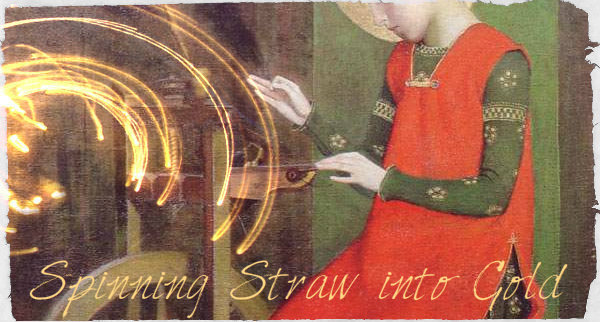This is a superb re-telling, made to accompany a virtual item on Gaia Online.
I'm not sure of the artist and author. Words and images were provided here.
In a frozen land far from any place you have ever been, where night seemed as eternal as the cold, there reigned a queen made of ice. She was cruel and beautiful, her subjects frigid spirits, her servants souls she had taken pity upon and rescued from certain death in the cold.
The snow queen was vain as well. She enchanted a mirror to show her the fairest woman in the kingdom, and of course, hers was always the face she would see.
Among the queen's servants, her favorite was a child she had taken from the snow. She was quiet and hard working, and plain, the part that the queen liked most. The girl was called Snow White.
Years passed, and Snow White grew into a young woman. One day the queen asked her mirror to show her the most beautiful woman in the kingdom. . . And to her horror, the traitorous mirror did not show her own face, but the likeness of her servant.
Enraged, she summoned her most powerful minion, the Yeti. She ordered him to take Snow White far out into the wilderness, and return with her frozen heart.
The Yeti obeyed and lead Snow White far across the ice, into the circle of the world that is only frozen ocean. There, he looked upon her, shivering and cold, and could not bring himself to kill her. He told her to run and hide where the queen could never find her.
Terrified, Snow White ran and ran until her lungs burned in the cold air and her legs gave out under her. Lying in the snow, she knew she would die if she didn't get up. But her eyelids felt so heavy, and the snow felt almost warm. . .
And when she opened them, she WAS warm! Piled around her were seven sled dogs, the same colors as the rocks and ice, almost as if they were born of the land.
When she asked them who they were, they replied, "We are the workers of the snow and ice. We can run forever and never fall, and despite the long cold night we will never freeze. Stay with us, young one, and we'll teach you the ways of the winter, and make you strong." She gladly agreed. Months passed. . .
And Snow White's spirit grew fierce. Even so far beyond the edges of the queen's kingdom, the enchanted mirror could see no one else. The queen knew her minion had betrayed her, and also, looking upon the face of the girl she had condemned to death. . . She felt a terrible fear.
She called upon her own ferocious spirit, casting a spell to transform herself into a great white bear. She hid between her claws a sliver of ice from the very top of the world, so cold it froze anything it touched.
The queen travelled far across the ice, tracking Snow White for many weeks. Finally, they found each other in the wasteland. Snow White could not recognize the queen, and saw only a bear threatening her dogs. She lunged towards the bear even as it charged her, as fearless as she was certain that she would not emerge alive. The queen's heart trembled as she looked upon the girl, and saw her death in those dark eyes.
The bear faltered, its claws missing Snow White by a breath, and she saw her harpoon's opening, sealing the fate of the beast. As she stood, she suddenly recognized the queen. She felt a sharp pain in her chest, and looking down, she found the shard of ice, lodged in her heart. The familiar beating of her blood stopped cold. Even her breath froze.
The seven dogs ran to her, but there was nothing they could do. They nipped at her boots and barked for attention, but she would not wake. Overcome with sorrow, they threw their voices to the wind, calling for help that they knew would not come.
And then, a miracle happened! A survivalist named Les Cannon happened to be filming nearby, and heard the mournful howls. Adventurous and bold, he immediately determined to discover the source.
Upon arriving, he saw the frozen Snow White, and was moved. He dropped his equipment and labored to revive her. As their lips met, albeit in the breath of resuscitation and not the legendary prince's kiss, the spark thrown off from the clash of their two strong spirits melted the ice in her heart, and it leapt in her chest.
Together with the seven dogs, Snow White and Les Cannon trekked back through the winterland, intending to alert the frozen kingdom of their liberation from the queen. As the palace grew larger on the horizon, so did the faint warm blush of a long dawn. Day had come at last.









